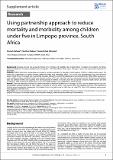| dc.contributor.author | Sivhaga, Kennedy | |
| dc.contributor.author | Hlabano, Boniface | |
| dc.contributor.author | Odhiambo, Penina Ochola | |
| dc.date.accessioned | 2021-08-17T12:46:27Z | |
| dc.date.available | 2021-08-17T12:46:27Z | |
| dc.date.issued | 12/26/2012 | |
| dc.identifier.citation | : Kennedy Sivhaga, Boniface Hlabano, Penina Ochola Odhiambo. Using partnership approach to reduce mortality and morbidity among children under five in Limpopo province, South Africa. Pan Afr Med J. 2012;13(Supp 1):14 | en_US |
| dc.identifier.issn | 1937-8688 | |
| dc.identifier.uri | http://dspace.amref.org/handle/123456789/69 | |
| dc.description | This article is published as part of the supplement “AMREF´s evidence in advancing the health of women and children”
Supplement sponsored by AMREF - African Medical and Research Foundation
© Kennedy Sivhaga et al. The Pan African Medical Journal - ISSN 1937-8688. This is an Open Access article distributed under the terms of the Creative Commons Attribution License (http://creativecommons.org/licenses/by/2.0), which permits unrestricted use, distribution, and reproduction in any medium, provided the original work
is properly cited. | en_US |
| dc.description.abstract | Background: Limpopo province has among the highest child mortality and morbidity rates in South Africa. To address this problem, the African
Medical and Research Foundation implemented an integrated c-IMCI and child survival project. This paper reports the organization’s experience in
the project.
Methods: AMREF South Africa implemented and tested a replicable approach for integrating health systems c-IMCI in a child survival project. The
project was implemented in Limpopo province, Makhuduthamaga local municipality which is one of the most disadvantaged and under-resourced
areas in South Africa. The project was implemented through a partnership model that included government departments, NGOs, CBOs, local government, traditional leaders, traditional healer’s practitioners, mothers of children under five and other community structures. Monitoring and evaluation
data was collected monthly and quarterly from the households of mothers of children under five by trained community health workers and their
coordinators. Data regarding the performance on key child health indicators was obtained from health facilities.
Results: There was improved performance in health indicators for diarrhoea incidence which dropped to 5/1000 from the baseline figure of 54/1000.
Immunisation coverage improved by 11%. Vitamin A coverage for children under 1 year rose to 45% from a baseline of 27.2%. The proportion of
facilities providing integrated management of childhood illness in the district rose to 100% from an initial 75%. Rate of HIV positivity among underfives dropped to 12% from 17%.
Conclusion: Use of partnerships through structures such as project task teams and Project steering committee is fundamental in ensuring good
progress in reduction of diarrheal incidence, immunization coverage, sustainability and ownership of interventions. | en_US |
| dc.description.sponsorship | UBS-Optimus Foundation | en_US |
| dc.language.iso | en | en_US |
| dc.publisher | Pan African Medical Journal. | en_US |
| dc.subject | Integrated community management of childhood illnesses | en_US |
| dc.subject | Community health workers | en_US |
| dc.subject | Partnerships | en_US |
| dc.title | Using Partnership Approach to Reduce Mortality and Morbidity Among Children Under Five in Limpopo Province, South Africa | en_US |
| dc.type | Article, Journal | en_US |

